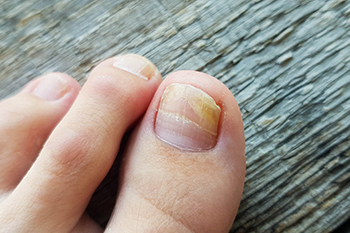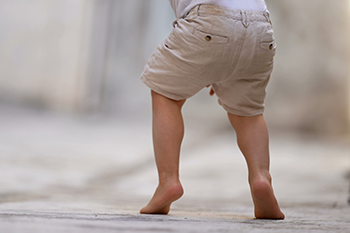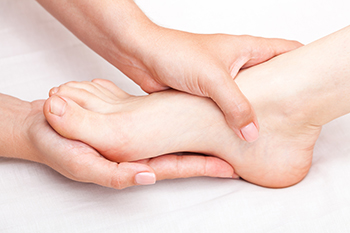Flint Office
1303 S. Linden Rd., Suite D
Flint, MI 48532

The toenails are easily ignored when thinking about basic healthcare, but there are many simple ways to keep them pain and problem free. Probably the two most common ailments are ingrown toenails and toenail fungus. An ingrown toenail is usually the result of the nail being cut incorrectly. It is suggested that cutting toenails straight across and not too short can prevent the nail from growing into the nail bed rather than over it. Fungal infections of the toenails can easily be spread in warm and moist areas, such as gym locker rooms and indoor swimming pools. Wearing protective foot coverings is a good way to prevent this annoying infection. Fungal toenail infections are extremely contagious, so it’s wise to keep from touching the infected area. If you have toenail fungal infections that recur, even after applying commercial anti-fungal remedies, it is a good idea to make an appointment with a podiatrist who can prescribe more powerful medication. In addition, trying to fix an ingrown toenail can lead to a bacterial infection. It is suggested that you make an appointment with a podiatrist who can safely deal with the problem.
If left untreated, toenail fungus may spread to other toenails, skin, or even fingernails. If you suspect you have toenail fungus it is important to seek treatment right away. For more information about treatment, contact one of our podiatrists of Community Podiatry Group. Our doctors can provide the care you need to keep you pain-free and on your feet.
Symptoms
Treatment
If self-care strategies and over-the-counter medications does not help your fungus, your podiatrist may give you a prescription drug instead. Even if you find relief from your toenail fungus symptoms, you may experience a repeat infection in the future.
Prevention
In order to prevent getting toenail fungus in the future, you should always make sure to wash your feet with soap and water. After washing, it is important to dry your feet thoroughly especially in between the toes. When trimming your toenails, be sure to trim straight across instead of in a rounded shape. It is crucial not to cover up discolored nails with nail polish because that will prevent your nail from being able to “breathe”.
In some cases, surgical procedure may be needed to remove the toenail fungus. Consult with your podiatrist about the best treatment options for your case of toenail fungus.
If you have any questions, please feel free to contact our office located in Flint, MI . We offer the newest diagnostic and treatment technologies for all your foot care needs.

Those who suffer from pain in the joints of their feet may be suffering from a form of arthritis. Rheumatoid arthritis, or RA, is a type of inflammatory arthritis that can affect the joints in the feet. With this autoimmune disorder, the immune system attempts to destroy the lining of the joints, called synovium, as well as the fluid in the joints. Pain may be felt in the joints, as well as the ligaments of the feet, which are bands of tissue that connect bones. Rheumatoid arthritis can also cause heel pain, compressed nerves, skin rashes, and nodules on the feet. Over time, RA causes cartilage erosion, and the joints in the feet may become deformed. Discomfort is often worse after prolonged time on the feet, and wearing shoes can be difficult. This condition can significantly impact the ability to walk, and it is beneficial for the patient to do what they can to manage the pain. If you suffer from rheumatoid arthritis and your feet are affected, it is suggested that you visit a podiatrist regularly who can help you effectively manage this condition.
Because RA affects more than just your joints, including the joints in your feet and ankles, it is important to seek early diagnosis from your podiatrist if you feel like the pain in your feet might be caused by RA. For more information, contact one of our podiatrists of Community Podiatry Group. Our doctors will assist you with all of your podiatric concerns.
What Is Rheumatoid Arthritis?
Rheumatoid Arthritis (RA) is an autoimmune disorder in which the body’s own immune system attacks the membranes surrounding the joints. Inflammation of the lining and eventually the destruction of the joint’s cartilage and bone occur, causing severe pain and immobility.
Rheumatoid Arthritis of the Feet
Although RA usually attacks multiple bones and joints throughout the entire body, almost 90 percent of cases result in pain in the foot or ankle area.
Symptoms
Diagnosis
Quick diagnosis of RA in the feet is important so that the podiatrist can treat the area effectively. Your doctor will ask you about your medical history, occupation, and lifestyle to determine the origin of the condition. Rheumatoid Factor tests help to determine if someone is affected by the disease.
If you have any questions please feel free to contact our office located in Flint, MI . We offer the newest diagnostic and treatment technologies for all your foot and ankle needs.

As toddlers learn to walk, they often place more weight on their toes than on the heels or soles of the feet. Experts believe that this is not necessarily indicative of any underlying medical condition or biomechanical abnormality. In fact, recent studies show that most toe walkers will outgrow this habit by the time they enter kindergarten. That said, if a child continues to walk on their toes as they get older, it may in fact may be a sign of neuromuscular or neurodevelopmental disorders, such as cerebral palsy or autism. Symptoms to watch for include stiff leg muscles, tightened Achilles tendons, and noticeable lack of coordination. Additionally, noticing a period of normal walking followed by toe walking, communication problems, and other physical abnormalities may be signs to visit a specialist. In those cases, it is suggested that parents who notice these symptoms contact a podiatrist. This type of foot doctor, who is trained to recognize the significance of such behaviors, can then examine the child’s gait, legs, and feet to determine the best course of action.
The health of a child’s feet is vital to their overall well-being. If you have any questions regarding foot health, contact one of our podiatrists of Community Podiatry Group. Our doctors can provide the care you need to keep you pain-free and on your feet.
Tips for Keeping Children's Feet Healthy
If you have any questions, please feel free to contact our office located in Flint, MI . We offer the newest diagnostic and treatment technologies for all your foot care needs.

Patients who have flat feet are lacking an arch, which is noticeable while standing up. It is also referred to as fallen arches or pes planus, and the majority of babies are born with this condition. The baby's arch will gradually form as the ligaments and tendons in the leg become tighter, and will be fully developed during the teenage years. In a small percentage of adults the arch does not develop, and this may be caused by an illness or injury. It may also happen from genetic reasons and may be more prevalent as the aging process occurs. Obesity may significantly contribute to having flat feet, in addition to rheumatoid arthritis and diabetes. Patients may notice their feet constantly ache, and mild relief may be found when custom-made orthotics are worn and specific stretches are performed. If you are afflicted with flat feet, it is suggested that you are under the care of a podiatrist who can guide you toward management techniques.
Flatfoot is a condition many people suffer from. If you have flat feet, contact one of our podiatrists from Community Podiatry Group. Our doctors will treat your foot and ankle needs.
What Are Flat Feet?
Flatfoot is a condition in which the arch of the foot is depressed and the sole of the foot is almost completely in contact with the ground. About 20-30% of the population generally has flat feet because their arches never formed during growth.
Conditions & Problems:
Having flat feet makes it difficult to run or walk because of the stress placed on the ankles.
Alignment – The general alignment of your legs can be disrupted, because the ankles move inward which can cause major discomfort.
Knees – If you have complications with your knees, flat feet can be a contributor to arthritis in that area.
Symptoms
Treatment
If you are experiencing pain and stress on the foot you may weaken the posterior tibial tendon, which runs around the inside of the ankle.
If you have any questions please feel free to contact our office located in Flint, MI . We offer the newest diagnostic and treatment technologies for all your foot and ankle needs.

Podiatrists are foot specialists that are specially trained in addressing different afflictions of the feet. They are trusted medical professionals who can treat a range of various foot conditions, from plantar fasciitis to hammertoe. It is important to note there are different types of podiatrists who may specialize in specific areas in the field of podiatry. For example, one such kind of podiatrist is known as a sports podiatrist. As the name suggests, this type of podiatrist works primarily with athletes and those who engage in sports. A sports podiatrist is well-versed in understanding, recognizing, and treating the nuances of foot injuries in the context of sports. Some of these sports podiatrists are engaged in producing research in their field. These podiatrists are easily able to identify the foot afflictions that most affect athletes. To learn more about the different types of podiatrists available to help you address any foot problems, it is suggested that you schedule an appointment with a podiatrist today.
If you are experiencing pain in the feet or ankles, don’t join the stubborn majority refusing treatment. Feel free to contact one of our podiatrists from Community Podiatry Group. Our doctors can provide the care you need to keep you pain-free and on your feet.
What Is a Podiatrist?
Someone would seek the care of a podiatrist if they have suffered a foot injury or have common foot ailments such as heal spurs, bunions, arch problems, deformities, ingrown toenails, corns, foot and ankle problems, etc.
Podiatric Treatment
A podiatrist will treat the problematic areas of the feet, ankle or lower leg by prescribing the following:
A common podiatric procedure a podiatrist will use is a scanner or force plate which will allow the podiatrist to know the designs of orthotics. Patients are then told to follow a series of tasks to complete the treatment. The computer will scan the foot a see which areas show weight distribution and pressure points. The podiatrist will read the analysis and then determine which treatment plans are available.
If you have any questions please feel free to contact our office located in Flint, MI . We offer the newest diagnostic and treatment technologies for all your foot and ankle needs.